 The last moments of 917....
The last moments of 917....  The last moments of 917....
The last moments of 917....
Thanks to Dave Crouse for this in depth update of the fate of 917....
Dear OAE et al:
I can't seem to stop myself from going back to look over the exploits and
adventures of the folks that made up VX-6 and VXE-6, it was, and still is, an
experience that is difficult if not impossible to describe to someone who has
not "been there, done that."
Since I was on my 8th VXE-6 LC-130L/R flight on January 28, 1973, aboard
Aircraft Buno. 155917, I can give some "first hand" information about
the way that particular flight ended.
As a new pilot to the squadron, and relatively new to the C-130, I felt it was
my duty and my privilege to be able to "hop" almost any flight leaving
from Williams Field in an effort to build time in the aircraft and learn the
mysterious ways of the Antarctic Continent.
The "final" flight of 917 was routine from the preflight to the take
off and climb out. At this point in time, I don't remember if the flight
was scheduled to be a double shuttle or not. As it turned out, it was not.
The pilot, whose name I will leave out because he cannot comment on the
statements I make here, was an experienced pilot in the C-130 and had
accumulated a lot of Antarctic Experience.
I was allowed to sit in the left seat for the "boring" part of the
flight over Beardmore and onto the Polar plateau. This part of the flight was
very uneventful. At our first radio contact with "Old" Pole
Station, we were informed that they were in and out of "White Out"
conditions. Normal procedures, as I recall them, were to make a GCA
approach to the field, and if unable to land to remain in the local area for a
"safe" period of time.
If a safe landing could not be made the flight was to return to McMurdo.
With the possible "White Out" looking at us, the Command Pilot took
the left seat and I returned to my "station" on the flight deck lower
bunk. . .with harness. I was sitting next to the Navigator
Instructor for the remainder of the flight. We each monitored the GCA via
out headsets.
The let down and the approach went well up to about 1 mile from touch down. The
GCA controller gave me a hand written recap of the GCA instructions that were
transmitted to the aircraft: "On course-on glide path/ on glide path on
course, 018 your heading/ on glide path at 2 miles from touchdown/ on glide
path/ turn right now to 020, on glide path, right now to 022, picked up a slight
left drift/ on glide path center line is very slightly right, 1 mile from
touchdown/on glide path, center line is slightly right correcting slowly,/ on
glide path coming up on course, left to 020,/ on glide path left to 018/on
course now going above/slightly/above/ slightly above, above glide path, take a
wave-off, too far above glide path./ climb out straight ahead.
Upon reaching 11,000 standby for further clearance." Inside the
cockpit, the pilot, who had been following the directions of GCA shifted his
scan to the outside of the aircraft. . .which, in retrospect, was the wrong
thing to do.
The pilot spotted one of the black marker drums at the approach end of the
skiway, at which time he said words to the effect, "I have the runway, I
have the airplane." At this time, of course, the copilot had started
the throttles forward. The pilot took the controls and closed all 4
throttles and started a transition back to the landing attitude. All of
this took place in a short period of time, and from my position on the bunk
behind the pilot, I also saw one of the marker barrels pass underneath the left
wing.
From the records of the people at Pole Station we know that our rate of descent
was excessive. If my memory serves me correctly, it was over 1000 feet per
minute. The pilot made his transition to the landing attitude just at the
time we contacted the skiway. The landing was very hard, but it did not
seem excessive to anyone on the flight deck at the time. Our attitudes
changed rapidly. The aircraft was moving toward the left side of the
skiway, but had a slight right tilt. At this time, we experienced the only
"injury" to the crew. The copilot was attempting to correct the
left drift. By using all of the right rudder he could muster, and in the
process, pushed so hard with his left foot on his right that he bruised the
right foot and nearly collapsed his arch. None of us, and certainly not
the copilot, was aware that the tail had separated from the aircraft and his
effort was accomplishing nothing.
After the fact, we know that the plane touched down at about the 850 foot mark
from the end of the skiway. . .and nearly in the center. The force of the
landing caused the wings to flex all the way to the skiway surface. It has
been a matter of discussion that, had it been concrete runway, the wings might
have survived. Because the skiway is only hard-pack snow, the wing tips
dug into the surface and broke away from the main wing just outboard of the
inboard engines. The wing tanks, outer wing surfaces and the outboard
engines went their separate ways. The propellers separated from the
outboard engines and went on their separate ways.
The force of the landing crushed the main landing gear and skis. They tore
free and also went their separate ways.
The tail section broke free of the main body of the aircraft at the head of the
loading ramp. The tail section followed right along behind the main
fuselage and came to a stop about 8 to 10 feet aft of the main fuselage.
The main section of the aircraft continued at a slight left drift from the
skiway centerline and continued down the skiway coming to rest, almost level,
just past the large plywood "8" (8,000 feet remaining) marker on the
port side of the skiway. Total distance covered from impact to stop was
approximately 1,150 feet.
From the cockpit, things did not appear too different from any other landing,
with the exception that we started a very slight starboard roll. This was
our first clue that things were "not" normal. When the aircraft came
to rest, everyone knew that we had NOT made a normal landing. The flight
engineer went down the steps to open the flight deck door. . .it would not move.
At this point the load master had moved to the bottom of the flight deck
steps and was saying something about a "FIRE" To emphasize his
statement, smoke was drifting from the cargo area up into the cockpit.
As we came to rest, there was not any sign of panic, however, with the idea of
fire, we were all a little eager to leave the aircraft.
When I saw that the flight deck door would not open, I reached up and opened the
overhead hatch above the upper flight deck bunk. At this point I was ready
to "lead" the troops to safety via the open hatch. Unfortunately,
when you open the overhead hatch, it comes into the aircraft and must be moved
out of the way. Since I opened the hatch, I was the lucky one to have to find a
place to "stow" it. I could not tell you where I put it,
but it did get
stowed.
Everyone exited the overhead hatch to the sight, but no sound, of the aircraft
burning. The wings were just "stubs" and the ends of the stubs
were dumping all of the remaining fuel from the ruptured fuel tanks. Either
the hot engines or the friction of the tearing metal had ignited the fuel.
Most of the fuel was consumed by the flames as it fell to the surface.
There was a tall column of smoke rising from both wing stubs into an even
bigger column of smoke that was left from the "burning fire ball" of
the aerated fuel that had been sprayed from the separating wings. This
"fireball" was what the people at the station saw.
In order to "depart" the aircraft, it was necessary to
"slide" down the side of the cockpit and make the drop of a few feet
to the skiway surface. For what ever reason, the Student Navigator tried
to slide down on his stomach and ended up straddling one of the blade radio
antennas. Looking back, it was funny. . .at the time, it was something
that was slowing us down.
The one person that did not "believe" that we were in trouble was the
pilot. With the aircraft burning, we did not know if there would be an explosion
or not and it seemed like a good idea to "leave the area." The
pilot would allow himself to be pushed and dragged for a few feet, but would
then turn and stare at the burning aircraft in shock and total disbelief. Everyone
else was eager to get as far from the aircraft as possible, including our two
passengers. . .who were SeaBee Hard Hat divers wanting to say they had been to
the "South Pole" . . . they got their wish and then some.
The outside temperature at the time was -57. To my knowledge no one ever
talked about "Wind Chill" even though the wind was usually blowing
anywhere from 10 to 30 knots and often even more than that. What
difference does it make if it is -57 or -90 with the "wind chill"?
Cold is cold.
At the time of impact, the only people in the crew that were wearing their
parkas on were the load master and the passengers because they were the only
people planning on leaving the aircraft. Of the rest of the flight crew
only the flight engineer and the Navigator Instructor were "smart
enough," or calm enough, to retrieve and wear their parkas. The rest
of us were leaving with the standard "waffleweave" and flight suits.
Because of the adrenaline rush, no one noticed the cold for quite some
time.
We began our transit to the "Old Pole Station" en masse. After
about 1000 feet, we were picked up by a D-8 Caterpillar that was headed back to
the station. The driver was totally stunned to find the crew walking on
the skiway.
At the station, manned by a total of 8 people, we found the remaining 7 members
packing "body bags" on sleds. To say they were surprised would
be a gross understatement. They were shocked! From what they could
see, the rising fireball and the "instant" silence from the radios,
they believed that there were certainly fatalities (they believed we had all
perished).
The aircraft had, in addition to a lot of "miscellaneous" cargo, two
fuel bladders holding "engine" fuel for the reciprocating engines on
the equipment at the station. One of the bladders was secured to the ramp
and was pulled free when the aircraft broke in half. The bladder
caught fire from either friction or the burning fuel from the wing stubs. It
did burn for several hours and made a hole that was close to 100 feet deep.
The smoke could be seen rising from the hole for several hours.
I don't think anyone got any sleep during the time we waited for a rescue flight
from McMurdo. I was part of the group that went back and walked
through the crash field before the rescue and accident investigation team
arrived. The time from the crash until our "rescue" return to
McMurdo was about 18 hours.
It was several days before I got to resume my "training", but the rest
of my tour and the years that followed were concluded without any further
mishaps.
. . where I was involved. . .thank goodness.
Dave Crouse
LCDR, USN (Ret.)
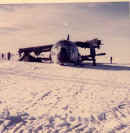 Final
Stop
Final
Stop
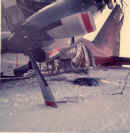 Port inboard engine
Port inboard engine
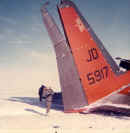 Starboard view tail section
Starboard view tail section 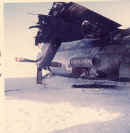 Port Wing
Port Wing
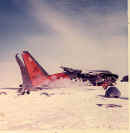 Starboard Full View.
Starboard Full View.
Note: Smoke and steam can be seen rising from the hole where the fuel bladder
burned into the snow. The photo is 12 to 16 hours after the crash.
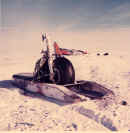 Wheel, strut and ski. Acft. in background.
Wheel, strut and ski. Acft. in background.
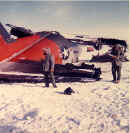 Rear view from stbd. aft.
Rear view from stbd. aft. 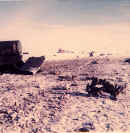 Debris field and wing fuel tank
Debris field and wing fuel tank
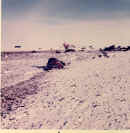 Long View of parts and skid marks
Long View of parts and skid marks
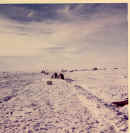 Second long view of skid marks and parts
Second long view of skid marks and parts
=
After
looking at some of the "other" pages relating to 917, I realize that I
did not give any credit to whoever took the pictures that I included with the
"short story".
I see that one of the photos that is credited to Ralph Lewis is identical, or
very close, to one that I included in the 10 that I sent to you.
I cannot confirm that the photos were given to me by Ralph Lewis. . .I know that
there were a few people from the crew and the station that returned to the crash
site while things were still "hot". . The fuel bladder was putting out
black smoke from the burning rubber. . .and I didn't think anyone had a camera
at that time. I, in all of my wisdom, made a pencil drawing
(Attached) of the crash area. It was/is very crude but does give a
reasonable layout of the debris and main body.
If you know Ralph Lewis, or if you can find out who the originator of the photos
was, they should get the credit for the photos. Of all I have seen, not
including the "official" photos, the ones I included seem to the the
best. They were given to me at McMurdo, but for the life of me, I cannot
remember the individual.
In looking at some of the "history" of the incident, I see names that
are not familiar to me. . .in particular the name of the Marine Major. . .I know
for a fact that the name given is NOT the Marine Major that was the pilot of
917.
Respectfully,
Dave Crouse
P.S. If I can help with any research, I do have access to some of the OAEs'
of the 72-76 era.
WOW, that is an amazing story.
Between '95 and 2000 I have accumulated 22 months at South Pole, with a
winter-over in '98. I've always have been curious as to how the events of that
fateful date in '73 came about. Over the years, it never seemed anyone on
station had much information about the crash. Ultimately the pilot in command
made a tough call. Thankfully you all walked away without any long term
disabilities. From your initial perception after set down on the skiway, it must
have been shocking to soon find out that the C130 was in numerous pieces, on
fire, and your evacuation was the utmost priority. Dave Pernic and I spent a few
days in late '97 trying to dig down to the aft ramp beneath the tail section. We
even had a few enthusiastic people assist us during that time. It was an
exhausting endeavor that really didn't make much result. We did get to the base
of the elevator, but that is about as far as we went. I suppose it was about 20
feet below the surface at that time. I believe the tail is completely subsurface
now. We thought it would be a great idea to unearth the fuselage and make
a Ceremonial South Pole Bar out of it. Your story surely gives credence to the
words 'WAVE OFF'.
Jon Conrad
South Pole electrician
=
5-01
I am down here now and thought you might like to know people are still
digging down and touring the wreck. It will not be possible much longer so
I also plan to take a peak before the sun comes up. Also thought you might
like a picture of a 130 from this summer.
Paul Daniels
Raytheon Polar Services Company
4-01
I remember that, I was at McMurdo at the time. One story circulating
around there, was that there was an RM3
Coast Guardsman aboard, who had been told that 'snow landings' were very rough,
and for him not to worry too much. After the landing, he supposedly asked
the loadmaster if he could get out now, and was told, get your tail moving, we
crashed.
SKCS John E. Wilson, USN(Ret), call sign, "Bozo Hammer".
2000
The guys flying 917 tried to duck under some low lying skud. When they
realized that they were looking at the snow surface and not
clouds they tried to go around but drug the aft section of the empenage. The
wings flexed so much that you could see where they dug into the ski-way. The
wings separated outboard of the inboard engines making what was left a twin
engine fireball. The tail section pealed off from right to left and two rubber
fuel bladders on pallets exited the aircraft catching fire on the way out. The
hole in the ski-way was about a thousand feet deep and still burning when I
arrived the next day with the investigation team.
Bob O'Keefe
=
2000
The report I read concerning the last flight of 917 was that it was
caused by the lack of the proper flap setting at the altitude of Pole
Station. The pictures that were sent to me showed a really demolished
C-130. I remember the year that we first got 917, it seems that it took
forever to get her from the states to the ice. Something about range and bad
winds as I remember it.
So much for the pylon tanks, huh. Lennie
I was crewmember on the aircraft when it crashed at Pole Station. Only 23 at the time and "bullet proof". It has been some time now that I had thought about it. For many years afterwards I relived the crash. It will never go away. I sensed something very wrong on the decent that day. I was in the cargo compartment and having made enough Ice landings, you have that "sixth sense" that kicks in that "somethings up....watch"
The Support personnel were rather shaken up with the landing to say the least. I guess we all were. We couldn't go out through the rear of the cargo compartment because of the smoke. I remember the details very distinctly. I watched the tail separate and the rubber "mo-gas" bladder lift up and shoot through the opening between the tail and main cargo section. It seemed like an eternity before the plane stopped sliding.
The pilot of C130 #917 was a Marine: Major Allen. He was my AC.
Patrick Yoas (former AE- USN)
Pyoas@yahoo.com
3-02 ZTC-1 Loadmaster Hazard
Crew members listed.
Maj. Allen
NAV Lcdr Wiebelhaus
Eng Don Miller, 2nd Eng Joe Donahue
Loadmaster ABH2 David Hazard
Inflight Scanner AE3 Patrick Yoas
Dave, I was the loadmaster on 155917 the day it crashed at the S. Pole. David V Hazard ABCS USN AC RET
You can add your input by e-mailing to vx6@radiocom.net